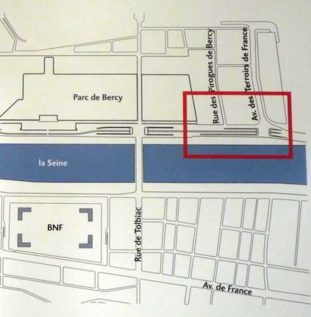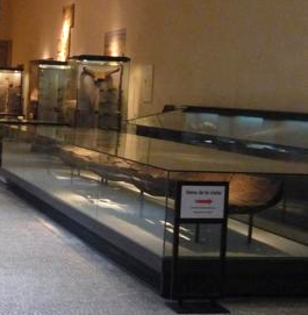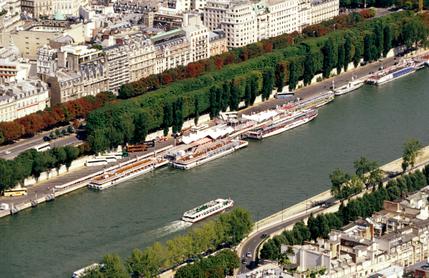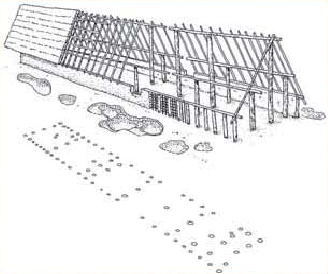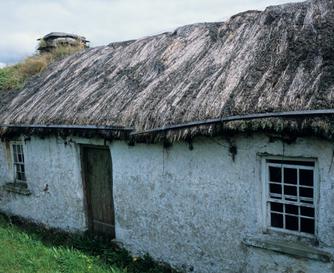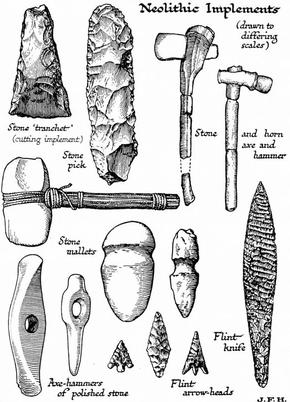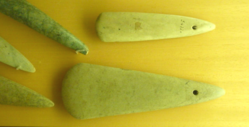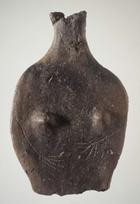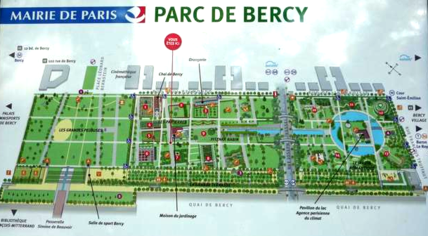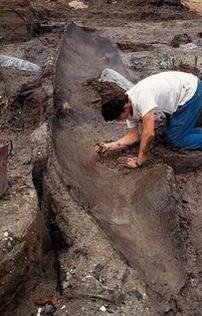Paris for Free - Neolithic Bercy
Women's Travel Abroad
For Women About Women By Women
While cruising the river I am surprised to see so many huge cargo barges.
I am told these barges, loaded with goods and products, have been a
vital part of the French economy and Parisian life for thousands of years.
A recent excavation at Paris-Bercy indicates water travel and trade on the Seine may date back almost 24,000 years to the Neolithic period.
These canoes were constructed around 4,000 B.C.. They were carved out of oak tree trunks. The inner pulp appears to have been burned away with fire. Adzes were most like used to shape and smooth the outside of the canoe. Each canoe is about 16 feet long and could hold up to six people. It is likely the canoes were propelled through the water by the use of paddles.
The Neolithic period was a time of great change for the Chasseen people, 4,300 B.C. to 3,800 B.C. who lived along the right bank of the Seine River at Paris-Bercy. These were the people who made the canoes. The Chasseens were some of the earliest pastorialists in the Paris river basin. Over time the Chasseen culture expanded geographically to include parts of northwestern and southeastern France.
Bercy, situated downstream from Paris, was quite large consisting of a community of between 100 to 400 individuals. They probably lived together in groups of 20 to 30 people in rectangular long houses. Three of these houses were unearthed at Paris-Bercy. Two other dwellings dated from the Chasseen period.
New tools and techniques developed to harvest, process, and store domesticated food. Grinding stones and burins became larger to efficiently process the ever increasing quantity of grain used for making porridge and flat bread that provided the Chasseen people with a year round supply of carbohydrates necessary to live their rigorous and busy lives of planting and harvesting.
Location of Neolithic Pirogues
Right Bank of Seine River
Paris-Bercy, France
Two Reconstructed Pirogues
Carnavalet Museum
Paris, France
Polished Flint
Ax-heads
Polished
Flint Blades
Mandibles
of
Domesticated
Animals
Saddle Burin
Grinding Stone
Auroch Horns
Polished flint blades and axes became popular and were added as essential tools to the Neolithic tool kit. Besides serving the utilitarian purpose of felling trees and cutting grain the blades may have also been highly venerated objects. Polishing flint takes a lot of time and energy. It requires the patience of a skillful artisan.
Clay Pottery, Figurines, and Beads
National Museum of Antiquities
Saint Germain en Laye, France
Despite what may appear to be improved living conditions during the Neolithic period early childhood death still occurred. A double burial found at Paris-Bercy contained the skeletons of two children, age 5 and 9, curled into a fetal position. Although no valuable objects were found in the grave this burial suggests a reverential attitude toward death. The children's grave is also a poignant reminder that even during the improved quality of living during the Neolithic period life was still unpredictable especially for the very young.
Although the Chasseen culture at Paris-Bercy seems to have died out by 300 B.C. trade up and down the Seine River continues to flourish today. I want to stay on the boat all the way to Port Bercy and visit this archaeological site but this passenger boat does not dock there. Public transportation on the Seine was discontinued in 1934 because of a decline in passengers and competition from the metro.
So I walk back to the Eiffel Tower terminal to catch the metro instead. Getting off at the Bercy metro stop, line 14, my adventure of getting to the site begins with a walk through the gardens in Bercy Park. On a map of the park I find it has two restrooms, several WiFi spots, a charming restaurant, and year-round covered skate park. In the warmer months the park offers refreshment stands, a carousel, and pony rides.
In Carrot City I find agricultural techniques that could have easily been practiced thousands of years ago. Branches support vegetation and clay pots with dwarf shrubs perch on the brick walls, adding a decorative touch to the landscape. Placards posted here and there tell me what seeds have been sown. Plants are tended and harvested with simple hand tools. Vegetables are grown alongside edible grasses and medicinal plants. Wooden bins are filled with composting vegetation.
Proceeding down a long cobbled walkway, beside the gardens and apartment buildings, I cross Rue Francois Truffout and arrive at Bercy Village. The arched entrance is straight ahead of me. To my right is the Cour Saint-Emilion metro stop. I walk past the enticing restaurants and enchanting shops through another entrance to Bercy Village. Emerging on the other side I reach my desired destination - the Rue Des Pirogues De Bercy.
I walk the railroad tracks from one end of Bercy Village to the other looking at the shop windows and canopied restaurants that occupy the new renovated warehouses previously used to store barrels of wine. The urban renewal project was completed in 2002 providing Bercy with charming mix of facilities for public welfare services, health care, businesses, entertainment venues, and residential housing.
Instead of having dinner at a restaurant in the Village I decide to pick up something to eat at the Monop store and go back to my studio for dinner. I leave Bercy happy with my groceries from Monop, treats from La Cure Gourmande, kitchen gadgets from Alice Delice tools, and memories of the Chasseen people of Neolithic Bercy.
Now I need to figure out what kind of transportation I will use to get home. Sadly tourist boats no longer dock at the Port of Bercy. Water transport would have been my first choice. Fortunately, there are other forms of public transportation that I can take to get back to my apartment. There is the bus, tram, and metro.
Experiences Internationales D'Agricultures Urbaines
International Experience in Urban Agriculture
Knapped
Stone Tools
Copyright 2017 Creative Travel Publications, LLC
Turning around I go back into the central area to explore Bercy Village. The Village appears to be an economic and entrepreneurial success. All the shop fronts are filled with some kind of business. Most of the restaurants are open daily from 11:00 AM to 9:00 PM. Many are closed on Sunday. The Village has free restrooms, an ATM machine, Club Med gym, cinema, and art galleries. Bercy Village is for the most part handicapped accessible and family-friendly but navigating the cobbled pathways in a wheel chair or with a baby buggy might be a little bumpy. On the bercyvillage.com website there is lots of information about public activities, restaurants, and shops plus a detailed map of the Village.
One of my favorite stores is the La Cure Gourmande. Bins of candy and cookies tempt me to fill up a bag full of delicious treats. Tins and boxes of chocolate are displayed in cupboards along the wall. YUM!
Another store I really like is Alice Delice. I just had to stop and check out the latest kitchen gadgets. I buy several egg poachers, designed for the microwave, as gifts for family and friends at home. COOL!
Neolithic Artifacts From Paris-Bercy Excavation
Carnavalet Museum
Paris, France
Traditional Neolithic long houses were generally about 20 feet wide and 60 feet long. The basic structure was made of timber, walls were sealed with wattle and daub, and the high-pitched roofs were made of thatch. The dwellings often had only one door, no windows, and a hole to allow smoke from an internal fire to escape. They were usually divided into separate areas for working, sleeping, and storage. It is likely the domesticated animals also lived in the house with humans during inclement weather.
Houses that resemble Neolithic long houses can still be seen today. Of course, they tend to be smaller and house fewer people. However, unlike the more primitive Neolithic long houses, these homes generally have at least two doors, several glass casement windows, and central heating. Today domesticated animals, except family pets, live separately from humans in barns similar to Neolithic long houses.
INRAP
Neolithic Long House
From the top of the Eiffel Tower I can see the most spectacular view of Paris and the Seine River as it meanders through the city. Some of the boats moored along the river banks are lovely homes or elegant restaurants. I also see many open-air and glass-topped boats traversing the river. I hop aboard one of these tour boats to get an entirely different view of the river.
During the Neolithic hunting and gathering was still part of everyday life. The bow and arrow was used for hunting the aurochs, red deer, and wild boars that lived in the surrounding oak forest. Discarded beaver and turtle bones suggest they may have trapped smaller game. The Chasseen's used barbed hooks, made from bone, for fishing.
Gathering food was also a vital part of their lives. Many of the seeds found at the site indicate they may have used wild flora and fauna for food, medicine, dye, and fiber. Beeswax residue on pottery shards show wax was applied to pottery as a sealant. Honey was probably collected and used to preserve and sweeten food and as a curative.
The Chasseen residents of Paris-Bercy practiced subsistence farming by cultivating plants and domesticating animals. This was the greatest advancement of the agricultural revolution. No longer were these Neolithic people entirely dependent on wild animals and plants for their survival. They could now settle down and raise a larger portion of their own food and perhaps have extra to trade for luxury goods.
Calf Teeth
Domesticated Cattle
At Paris-Bercy researchers found bones of domesticated pigs, cattle, and sheep that are Neolithic ancestors of our modern-day farm animals. Isotope analysis of calf teeth show cattle were raised from birth to adulthood for milk and meat. The wet meadows surrounding the site provided good summer grazing land for these animals. Leaves, seeds, and twigs from oak trees may have provided the animals with winter food.
Grains and fruits were planted on open land where majestic oak forests had once been. Oak trees, felled to provide wood for the canoes and a ready source of fire wood for cooking and warmth, also opened land for planting crops. Seeds found at the site show grain and fruit was planted. Rye, millet, and grass was sown. Apple, plum, and pear trees were cultivated.
Clay was introduced and used for both utilitarian and decorative items. Large stone and small clay ovens were constructed outside and inside houses for cooking food and firing useful clay articles. Pottery appeared during this time and was probably used to hold harvested grain and dried fruit. Food was prepared and served in clay bowls. Even charming figurines and decorative beads were crafted from clay.
However, the pay-offs were worth the hard work. The act of polishing flint increased both it's strength and durability. Also, the blade edge was much easier to sharpen. Polished flint was the perfect tool for chopping down trees and cutting grain. These blades would have been attached to a wooden handle. The top of the handle was placed in the center of the blade.
It was held in place with a cross-wrapping of sinew. Polished flint ax-heads were secured into a hole in the wooden handle. It is possible the blades and axes found at Paris-Bercy were imported from Great Britain. Finds of flint blades at other Neolithic sites in Europe suggest the polished flint blades and ax-heads were traded over long distances.
Saddle Burin and Grinding Stones
National Museum of Antiquities
Saint Germain en Laye, France
Polished Flint Blades
National Museum of Antiquities
Saint Germain en Laye, France
Sinew Wrapped Arrow Blade
National Museum of Antiquities
Saint Germain en Laye, France
Feather Arrow Shaft
National Museum of Antiquities
Saint Germain en Laye, France
The last time I came here it was a it was a windy, cold, and wet day. This time it is a brisk, sunny, warm day. I sit down on a park bench and have lunch. I am always surprised by the lush green vegetation of Paris in autumn. Although leaves are falling off the trees the park is a profusion of purple, orange and yellow mums and pink rose buds cover thorny bushes.
I finish my picnic and continue wandering through the park. Walking by tranquil pools and delightful fountains I come upon Carrot City. Carrot City is an "international experience in urban agriculture" used as an educational tool for Parisian chidren . It seems to me this is the perfect location for such a venture. I sense the Neolithic Chasseen people would have felt at home in this environment.
Bercy Venus Figurine
Carnavalet Museum
Paris, France
The site of this stone age archaeological excavation is located on the right bank of the Seine just beyond the Pont Tournelle bridge. It extends from the modern day streets of Boulevard Vincent Auriol to Avenue des Terroin de France. The excavation was conducted during the late 1990s by INRAP under the direction of Philip Marquis and Yves Lanchon. The most astonishing find was a group of ten pirogues (dugout canoes) buried only forty feet below street level in many layers of sedimentary river rock.
French crepes, Italian pasta, and Irish food are among the many kinds of food served in the Bercy restaurants. Nicolas allows patrons to sample wine at their bar. There are several large chain stores like FNAC and Monop in the Village and small unique boutiques along with larger more familiar stores: Sephora cosmetics, Fragonard perfumes, and agnes b. clothing and accessories.
INRAP
I choose the metro line 14, called the Meteor by Parisians, at Cour Saint-Emilion stop just outside of the Bercy Village entrance. This relatively new, fully automated metro service was built in 1998. It is also sparkling clean and one of the few entirely handicapped-accessible metro stops in Paris. Straight ahead is a public elevator down to the metro platform.
The Cour Saint-Emilion metro stop replaced an old railroad station used for transporting French wine . It is named after the famous Saint Emilion red wine, produced in the Aquitaine area of France, that was shipped to Bercy and stored in the warehouses for distribution around the countryside and export to other countries. Hmm... sounds enticing. I wonder if I can buy a bottle at my neighborhood wine shop?
I stop here to reflect on the lives of the Chasseen's and my own family history. Up until just two generations ago my American relatives were agriculturalists. As a child I frequently visited their farms. My aunt and uncle practiced animal husbandry and grew grain as a source of animal feed raising cows for milk, chickens for eggs, and pigs for meat which they ate and sold . They also grew corn and hay to feed their animals. Immigrating from Europe to the United States they brought with them the agrarian legacy of the late Neolithic period.
During this visit to Bercy, in search of the remains of the Neolithic Chasseen settlement and canoe location, I am surprised to find only an iconic Parisian street sign marking the spot. Nowhere else have I seen directional signs or informational posters telling about the site of the dig. However, the stone walls inside Bercy Village display some exceptionally good art pieces for sale. I feel pleased to have already visited the early French history room at the Carnavalet Museum and actually viewed some of the finds, including two of the canoes, that were uncovered right here on this avenue.
INRAP
INRAP
Excavating a canoe on site at Neolithic Bercy.
You Are Welcome to Contact Me Personally With Comments or Questions
Destinations

